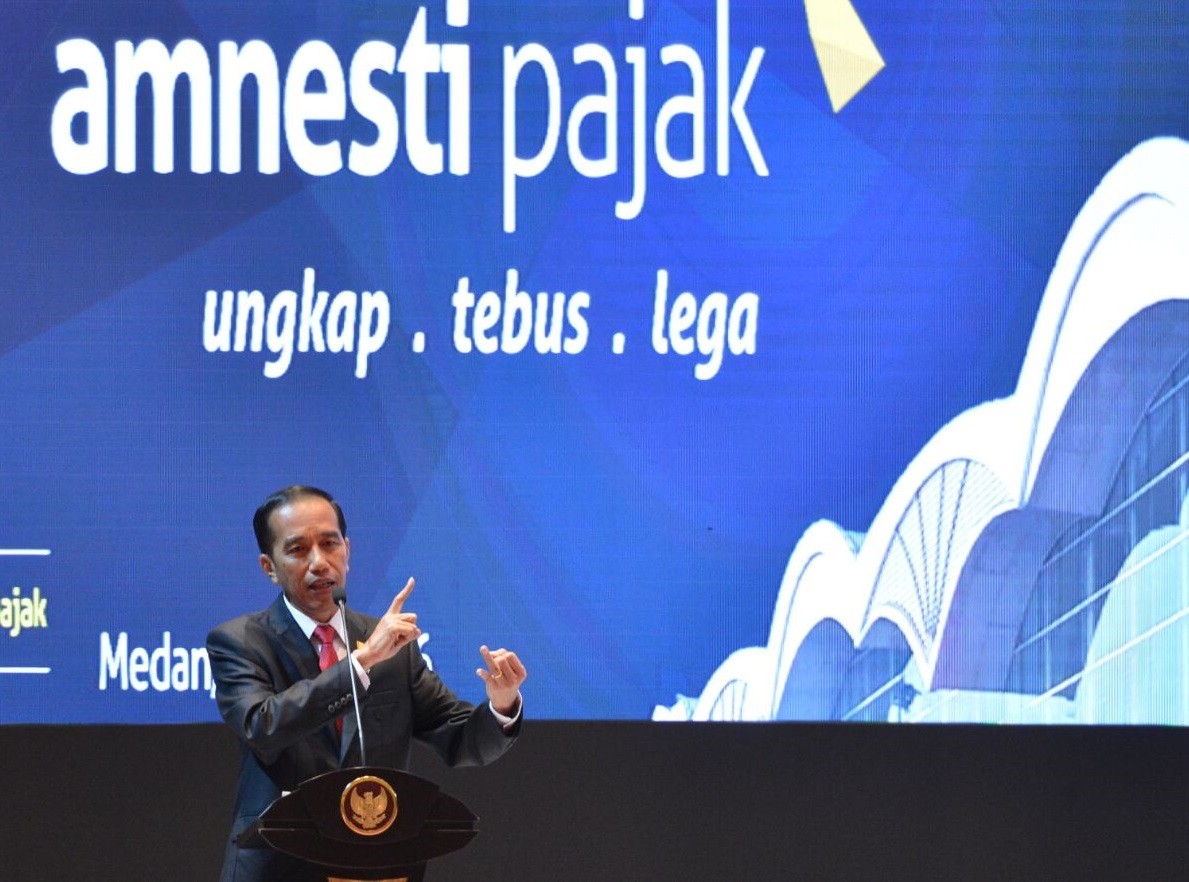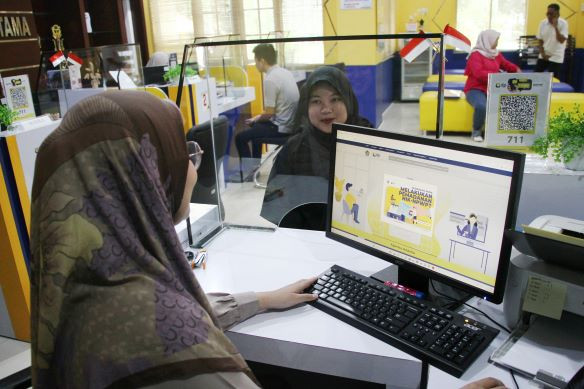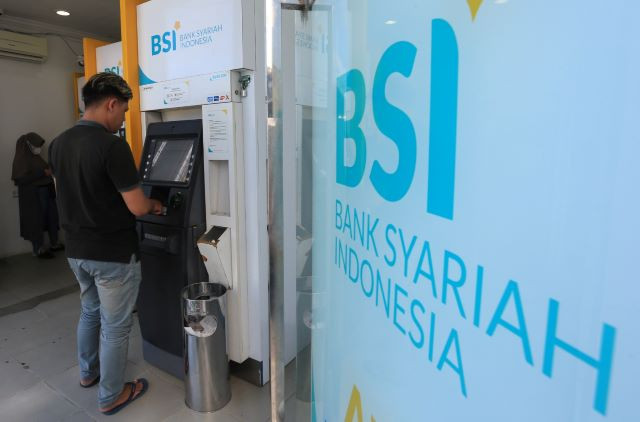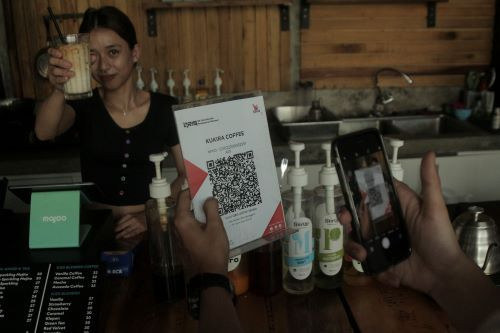Tax amnesty and challenges ahead in Indonesian banking
Financial disintermediation has become an important issue in the Indonesian banking system. If third-party funds (deposits) and loans grew by 18.2 percent and 25.5 percent in 2011, they would have accumulated only 6.9 percent and 10.5 percent interest, respectively, in May 2016.
Such trends can partly be explained by the supply-side factor in which the Indonesian banking system has been characterized by a relatively higher net interest margin (NIM) than other banking systems in Southeast Asia.
Change Size
 President Joko "Jokowi" Widodo speaks during a campaign on tax amnesty program in Medan, North Sumatra on July 21. (Presidential Secretariat/Laily Rachev)
President Joko "Jokowi" Widodo speaks during a campaign on tax amnesty program in Medan, North Sumatra on July 21. (Presidential Secretariat/Laily Rachev)
F
inancial disintermediation has become an important issue in the Indonesian banking system. If third-party funds (deposits) and loans grew by 18.2 percent and 25.5 percent in 2011, they would have accumulated only 6.9 percent and 10.5 percent interest, respectively, in May 2016.
Such trends can partly be explained by the supply-side factor in which the Indonesian banking system has been characterized by a relatively higher net interest margin (NIM) than other banking systems in Southeast Asia.
Indonesia’s NIM reached 5.4 percent in 2015 and 5.6 percent in May 2016, while NIM in Malaysia, Thailand and Philippines only reached 2.3 percent, 2.6 percent and 3.3 percent in 2015, respectively.
The high net interest margin could be related to low deposit rates or high lending rates. This may in turn affect demand for deposits and credit. Bank deposits might be less attractive to people if interest rates are low, while bank lending is also dampened when only a small amount of money is available in the banking industry and lending rates are high.
In a period of tight liquidity in the banking industry, the newly introduced tax amnesty may indeed provide breathing room for banks, as it may help restore liquidity caused by deposit decreases.
If the tax amnesty works well, some analysts predict that bank deposit growth could reach 18 to 20 percent by December, which may invigorate credit in 2017.
However, this can be achieved if the following three major challenges can be well managed.
First, trustee banks in the tax amnesty program are categorized as relatively large banks with high capacity to access funding. Although liquidity problems will seem to be resolved at the aggregate level due to a flood of liquidity at large banks, inherent liquidity problems will remain in smaller banks.
If this is the case, competition in the deposit market among smaller banks will intensify, particularly when smaller banks try to attract deposits by increasing interest rates to prevent deposits from moving to large banks.
The US experience following financial deregulation in the 1990s suggests an increase in competition in the deposit market, which in turn drove US banks to grant risky but profitable loans in order to cover higher interest rates.
Consequently, non-performing loans tend to increase. Following the introduction of the tax amnesty program in Indonesia, managing prudent competition among smaller banks is necessary, as the non-performing loans ratio at the aggregate level rose to 3.1 percent in May 2016 from 2.71 percent in January 2016.
Yet strengthening depositor protection and trust in small banks is also important to ensure that there is no “flight to safety” effects that cause liquidity evaporation in small banks, because depositors will go large banks.
Second, the use of funds obtained from overseas that enter the Indonesian banking system also needs particular attention. If competition in the deposit market seems detrimental to bank stability, competition in the credit market will drive lending rates lower.
Hence, the moral hazard of borrowers to take excessive risk due to high lending rates charged by banks will tend to decline. In turn, non-performing loans from entrepreneurs’ excessive risk taking may decrease, strengthening bank stability.
Efforts to promote prudent bank competition in the credit market is therefore of particular importance. Yet a closer look to identify economic sectors for which loans are distributed by the trustee banks is also essential.
If the trustee banks have expertise in lending to certain economic sectors, they may charge high lending rates to these sectors due to the market power of the trustee banks.
By promoting credit market competition, the trustee banks would be less inclined to increase lending rates, at least in the sectors they dominate, which in turn would promote greater access to bank credit and enhance stability.
Third, the structure of bank deposits in Indonesia is still dominated by short-term instruments. Although time deposits dominate, reaching 47 percent of total third-party funds in May 2016, one-month time deposits remain the most attractive and accounts for 50 percent of total time deposits.
On the contrary, time deposits with a maturity greater than one year only account for 11 percent of total time deposits. In this regard, the risk of maturity mismatch will remain substantial when loans have longer maturity than deposits, unless public confidence in longer-term savings instruments can be strengthened, and funds entering Indonesia in the tax amnesty program can be put into longer-term savings instruments.
Ultimately, the tax amnesty program is like two sides of the same coin. This can bring benefits to promote access to banking services and boost real sector development, but it may also create risks of liquidity, imprudent competition in the deposit market and maturity mismatch in the banking industry.
However, the benefits may outweigh the risks with effective prudential supervision, continuous moral suasion and information dissemination through intense financial literacy programs that may strengthen public trust.
Trust and financial literacy is indeed key to society choosing longer-term savings instruments in banking, as well as key to entrepreneurs using bank loans as sources of financing for their businesses.
***
The writer is a senior lecturer and financial economist at Sampoerna University’s School of Business, Jakarta. The views expressed are his own.
---------------
We are looking for information, opinions, and in-depth analysis from experts or scholars in a variety of fields. We choose articles based on facts or opinions about general news, as well as quality analysis and commentary about Indonesia or international events. Send your piece to community@jakpost.com. For more information click here.









